Meso-Cenozoic Exhumation of the Linqing Sub-Basin, Bohai Bay Basin: Implications for Cratonic Destruction
Abstract
:1. Introduction
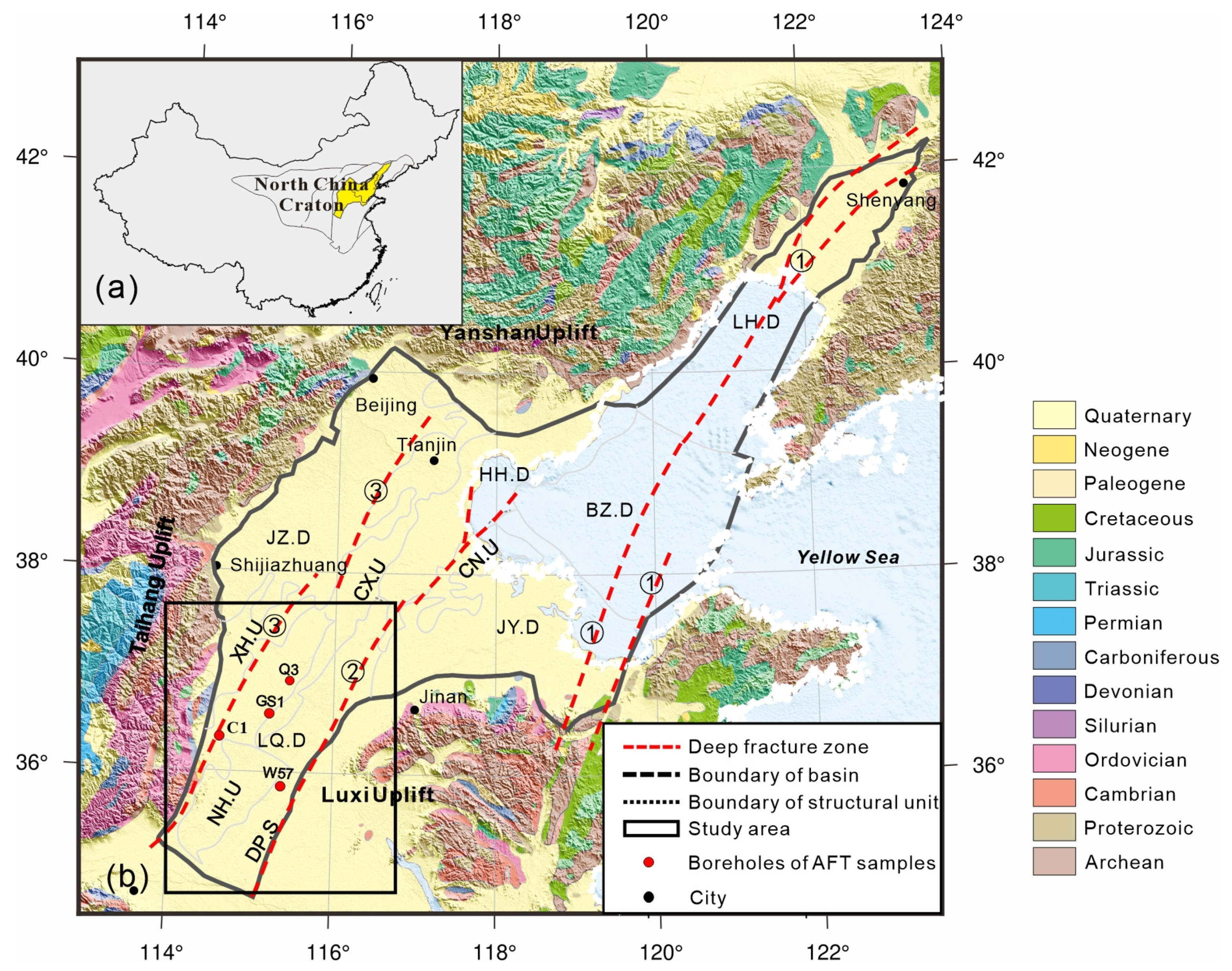
2. Geological Setting
3. Methods and Samples
3.1. Measurement of AFT and Samples
3.2. Estimation of Paleo-Temperature
3.3. Method of AFT Grain-Age Distribution Analysis
4. Results
5. Discussion
5.1. Minimum Age and the Recent Cooling Event
5.2. Implications for Cratonic Destruction
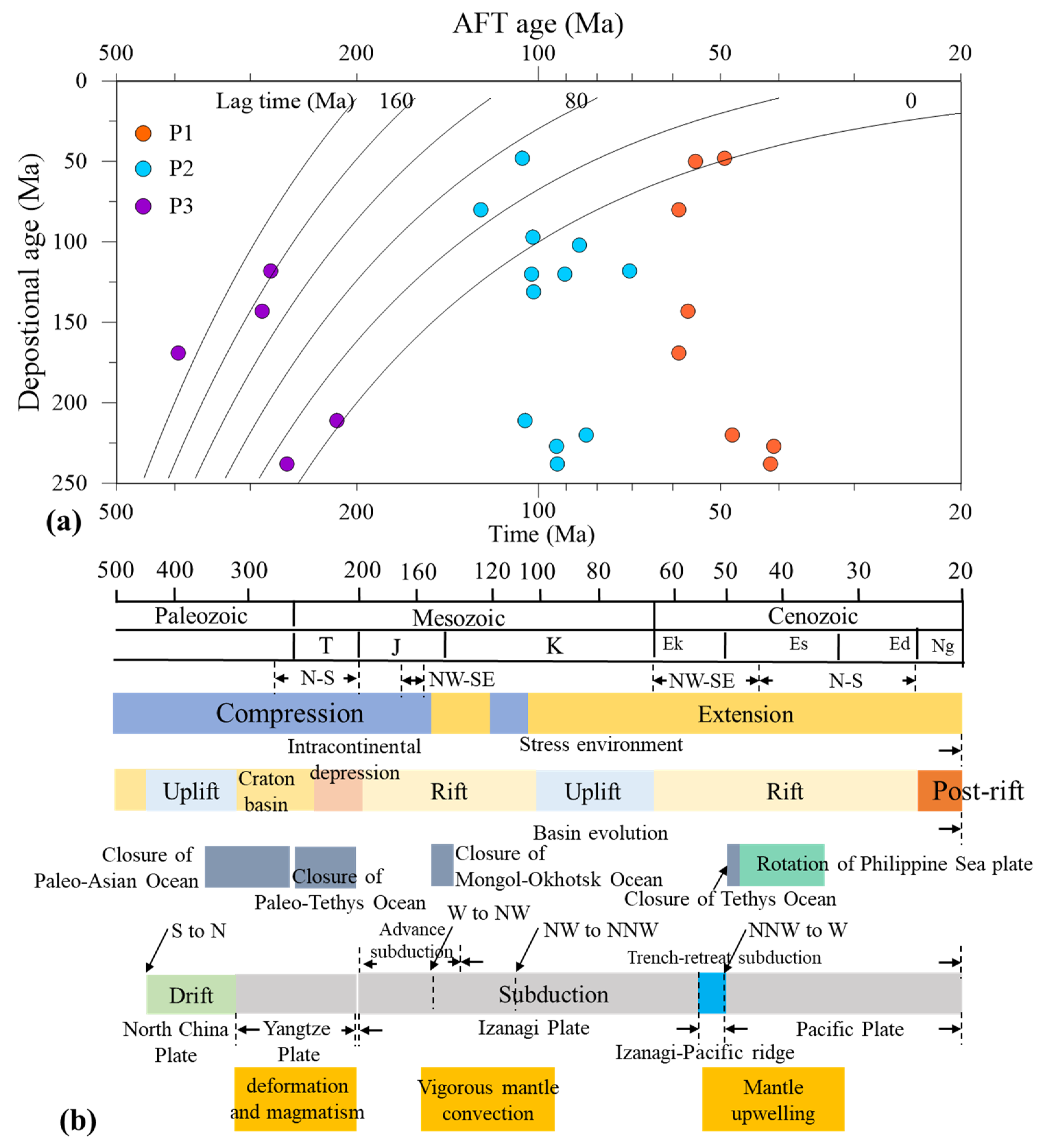
6. Conclusions
- AFT ages range from 124.4 ± 24.9 to 53.5 ± 5.4 Ma with mean track lengths ranging from 8.00 ± 2.51 to 11.24 ± 1.27 μm. Most of the AFT age data did not pass the P(χ2) test and could be divided into three age groups: P3 (394.8–215.7 Ma), P2 (124.6–83.4 Ma), and P1 (70.7-40.8 Ma).
- The minimum ages are concentrated in ca. 70.0−40.0 Ma, which represents the latest structural thermal reset event of the Linqing Depression. The break in slope observed from the depth-minimum age profile is commonly indicative of a distinct cooling episode and reflects a Meso-Cenozoic cooling event.
- Three peak age groups are correlated with the tectonic activities of the Paleozoic, Mesozoic, and Cenozoic.
Supplementary Materials
Author Contributions
Funding
Acknowledgments
Conflicts of Interest
References
- Liu, D.; Wilde, S.A.; Wan, Y.; Wu, J.; Zhou, H.; Dong, C.; Yin, X. New U-Pb and Hf isotopic data confirm Anshan as the oldest preserved segment of the North China Craton. Am. J. Sci. 2008, 308, 200–231. [Google Scholar] [CrossRef]
- Huang, Z.; Li, H.; Zheng, Y.; Peng, Y. The lithosphere of North China Craton from surface wave tomography. Earth Planet. Sci. Lett. 2009, 288, 164–173. [Google Scholar] [CrossRef]
- Tian, Y.; Zhao, D.; Sun, R.; Teng, J. Seismic imaging of the crust and upper mantle beneath the North China Craton. Phys. Earth Planet. Inter. 2009, 172, 169–182. [Google Scholar] [CrossRef]
- Zhu, J.; Cao, J.; Li, X.; Zhou, B. The Reconstruction of Preliminary Three dimensional Earth’s Model and Its Implications in China and Adjacent Regions. Acta Geophys. Sin. 1997, 40, 647–658. [Google Scholar]
- Zheng, J.; Lu, F.; O’Reilly, S.; Griffin, W.; Zhang, M. Comparison between Palaeozoic and Cenozoic lithospheric mantle in the eastern part of the North China block. Acta Geol. Sin. 1999, 73, 47–56. [Google Scholar]
- Griffin, W.L.; Andi, Z.; O’Reilly, S.Y.; Ryan, C.G. Phanerozoic Evolution of the Lithosphere Beneath the Sino-Korean Craton. In Mantle Dynamics and Plate Interactions in East Asia; Flower, M., Chung, S., Lo, C., Lee, T., Eds.; American Geophysical Union: Washington, DC, USA, 1998; pp. 107–126. [Google Scholar]
- Menzies, M.A.; Fan, W.; Zhang, M. Palaeozoic and Cenozoic lithoprobes and the loss of >120 km of Archaean lithosphere, Sino-Korean craton, China. In Magmatic Processes and Plate Tectonics; Prichard, H.M., Alabaster, T., Harris, N.B.W., Neary, C.R., Eds.; Special Publication No. 76; Geological Society Special Publication: London, UK, 1993; Volume 76, pp. 71–81. [Google Scholar]
- Yang, J.; Wu, F.; Wilde, S.A. A review of the geodynamic setting of large-scale Late Mesozoic gold mineralization in the North China Craton: An association with lithospheric thinning. Ore Geol. Rev. 2003, 23, 125–152. [Google Scholar] [CrossRef]
- Zhu, R.; Chen, L.; Wu, F.; Liu, J. Timing, scale and mechanism of the destruction of the North China Craton. Sci. China Earth Sci. 2011, 54, 789–797. [Google Scholar] [CrossRef]
- Chang, J.; Qiu, N.; Liu, S.; Cai, C.; Xu, Q.; Liu, N. Post-Triassic multiple exhumation of the Taihang Mountains revealed via low-T thermochronology: Implications for the paleo-geomorphologic reconstruction of the North China Craton. Gondwana Res. 2019, 68, 34–49. [Google Scholar] [CrossRef]
- Chang, J.; Qiu, N.; Zhao, X.; Shen, F.; Liu, N.; Xu, W. Mesozoic and Cenozoic tectono-thermal reconstruction of the western Bohai Bay Basin (East China) with implications for hydrocarbon generation and migration. J. Asian Earth Sci. 2018, 160, 380–395. [Google Scholar] [CrossRef]
- Hu, S.; O’Sullivan, P.B.; Raza, A.; Kohn, B.P. Thermal history and tectonic subsidence of the Bohai Basin, northern China: A Cenozoic rifted and local pull-apart basin. Phys. Earth Planet. Inter. 2001, 126, 221–235. [Google Scholar] [CrossRef]
- Qiu, N.; Zuo, Y.; Chang, J.; Li, W. Geothermal evidence of Meso-Cenozoic lithosphere thinning in the Jiyang sub-basin, Bohai Bay Basin, eastern North China Craton. Gondwana Res. 2014, 26, 1079–1092. [Google Scholar] [CrossRef]
- Qiu, N.; Zuo, Y.; Xu, W.; Li, W.; Chang, J.; Zhu, C. Meso-Cenozoic Lithosphere Thinning in the Eastern North China Craton: Evidence from Thermal History of the Bohai Bay Basin, North China. J. Geol. 2016, 124, 195–219. [Google Scholar] [CrossRef]
- Qi, J.; Yang, Q. Cenozoic structural deformation and dynamic processes of the Bohai Bay basin province, China. Mar. Pet. Geol. 2010, 27, 757–771. [Google Scholar] [CrossRef]
- Green, P.F. A new look at statistics in fission-track dating. Nucl. Tracks 1981, 5, 77–86. [Google Scholar] [CrossRef]
- Galbraith, R.F. On statistical models for fission track counts. J. Int. Assoc. Math. Geol. 1981, 13, 471–478. [Google Scholar] [CrossRef]
- Brandon, M.T.; Roden-Tice, M.K.; Garver, J.I. Late Cenozoic exhumation of the Cascadia accretionary wedge in the Olympic Mountains, northwest Washington State. Geol. Soc. Am. Bull. 1998, 110, 985–1009. [Google Scholar] [CrossRef]
- Galbraith, R.F.; Laslett, G.M. Statistical models for mixed fission track ages. Nucl. Tracks Radiat. Meas. 1993, 21, 459–470. [Google Scholar] [CrossRef]
- Xu, W.; Qiu, N.; Chang, J.; Zhou, Y.; Xiao, Y.; Liu, S. Mesozoic–Cenozoic thermal evolution of the Linqing Sub-basin, Bohai Bay Basin (eastern North China Craton): Constraints from vitrinite reflectance data and apatite fission track thermochronology. Geol. J. 2020, 55, 5049–5061. [Google Scholar] [CrossRef]
- Brandon, M.T. Decomposition of fission-track grain-age distributions. Am. J. Sci. 1992, 292, 535–564. [Google Scholar] [CrossRef]
- Brandon, M.T. Decomposition of mixed grain age distributions using Binomfit. Track 2002, 24, 13–18. [Google Scholar]
- Zhao, G.; Sun, M.; Wilde, S.A.; Li, S. Late Archean to Paleoproterozoic evolution of the North China Craton: Key issues revisited. Precambrian Res. 2005, 136, 177–202. [Google Scholar] [CrossRef]
- Kusky, T.; Li, J.; Santosh, M. The Paleoproterozoic North Hebei Orogen: North China craton’s collisional suture with the Columbia supercontinent. Gondwana Res. 2007, 12, 4–28. [Google Scholar] [CrossRef]
- Yang, J.H.; Wu, F.Y.; Wilde, S.A.; Belousova, E.; Griffin, W.L. Mesozoic decratonization of the North China block. Geology 2008, 36, 467–470. [Google Scholar] [CrossRef]
- Zhu, R.; Yang, J.; Wu, F. Timing of destruction of the North China Craton. Lithos 2012, 149, 51–60. [Google Scholar] [CrossRef]
- Wu, F.Y.; Xu, Y.G.; Gao, S.; Zheng, J.P. Lithospheric thinning and destruction of the North China Craton. Acta Petrol. Sin. 2008, 24, 1145–1174. [Google Scholar]
- Gao, S.; Rudnick, R.L.; Yuan, H.; Liu, X.; Liu, Y.; Xu, W.; Ling, W.; Ayers, J.; Wang, X.; Wang, Q. Recycling lower continental crust in the North China craton. Nature 2004, 432, 892–897. [Google Scholar] [CrossRef]
- Zhou, L.H.; Li, S.Z.; Liu, J.Z. Pre-Tertiary Tectonic Evolution and Buried Hill-Type Oil-Gas Development and Reservation under the Bohai Bay Basin; China Science and Technology Press: Beijing, China, 2003; pp. 2–22. [Google Scholar]
- Zhang, G. Structure and tectonics of Mesozoic basins in north and NE China. Acta Pet. Sin. 1997, 18, 7–13. [Google Scholar]
- Sun, Y.; Xu, S.; Zhang, S.; Li, Y.; Li, H.; Meng, T.; Liu, J. Evolution of the Mesozoic Source Rocks in the West Linqing Depression. Nat. Gas Geosci. 2015, 26, 1910–1916. [Google Scholar]
- Qi, J.F.; Zhang, Y.W.; Lu, K.Z.; Yang, Q. Cenozoic tectonic evolution in Bohai Bay Basin province. J. Univ. Pet. China 1995, 19, 1–6. [Google Scholar]
- Luo, Y.L. Linqing Depression Evaluation of Upper Paleozoic Oil and Gas Resources. Master’s Thesis, China University of Petroleum, Qingdao, China, 2011. [Google Scholar]
- Guo, H.; Xia, B.; Chen, G.; Wang, R.; Ding, J.; Wang, J. Geochemical and geotectonic features of Miocene basalts in Linqing Sag. Acta Pet. Sin. 2005, 26, 5–11. [Google Scholar]
- Naeser, C.W. The use of apatite and sphene for fission track age determinations. Geol. Soc. Am. Bull. 1967, 78, 1523–1526. [Google Scholar] [CrossRef]
- Barker, C.E.; Pawlewicz, M.J. Calculation of Vitrinite Reflectance from Thermal Histories and Peak Temperatures: A comparison of methods. In Vitrinite Reflectance as a Maturity Parameter: Applications and Limitations; Mukhopadhyay, P.K., Dow, W.G., Eds.; ACS Symposium Series 570; American Chemical Society: Washington, DC, USA, 1994; pp. 216–229. [Google Scholar]
- Barnes, J.B.; Ehlers, T.A.; McQuarrie, N.; O’Sullivan, P.B.; Pelletier, J.D. Eocene to recent variations in erosion across the central Andean fold-thrust belt, northern Bolivia: Implications for plateau evolution. Earth Planet. Sci. Lett. 2006, 248, 118–133. [Google Scholar] [CrossRef]
- Galbraith, R.F.; Green, P.F. Estimating the component ages in a finite mixture. Int. J. Radiat. Appl. Instrum. Part D Nucl. Tracks Radiat. Meas. 1990, 17, 197–206. [Google Scholar] [CrossRef]
- Zuo, Y.; Ye, B.; Wu, W.; Zhang, Y.; Ma, W.; Tang, S.; Zhou, Y. Present temperature field and Cenozoic thermal history in the Dongpu depression, Bohai Bay Basin, North China. Mar. Pet. Geol. 2017, 88, 696–711. [Google Scholar] [CrossRef]
- Gong, Y.L. The Thermal Structure and Thermal Evolution of Bohai Bay Basin Eastern China. Ph.D. Thesis, Nanjing University, Nanjing, China, 2003. [Google Scholar]
- Green, P.F.; Duddy, I.R.; Laslett, G.M.; Hegarty, K.A.; Gleadow, A.J.W.; Lovering, J.F. Thermal annealing of fission tracks in apatite 4. Quantitative modelling techniques and extension to geological timescales. Chem. Geol. Isot. Geosci. Sect. 1989, 79, 155–182. [Google Scholar] [CrossRef]
- Wolf, R.A.; Farley, K.A.; Kass, D.M. Modeling of the temperature sensitivity of the apatite (U–Th)/He thermochronometer. Chem. Geol. 1998, 148, 105–114. [Google Scholar] [CrossRef]
- Gleadow, A.J.; Brown, R.W. Fission-track thermochronology and the long-term denudational response to tectonics. In Geomorphology and Global Tectonics; Wiley: New York, NY, USA, 2000; pp. 57–75. [Google Scholar]
- Liu, J.; Zhao, Y.; Liu, A.; Zhang, S.; Yang, Z.; Zhuo, S. Origin of Late Palaeozoic bauxites in the North China Craton: Constraints from zircon U–Pb geochronology and in situ Hf isotopes. J. Geol. Soc. 2014, 171, 695–707. [Google Scholar] [CrossRef]
- Wang, Q.; Deng, J.; Liu, X.; Zhao, R.; Cai, S. Provenance of Late Carboniferous bauxite deposits in the North China Craton: New constraints on marginal arc construction and accretion processes. Gondwana Res. 2016, 38, 86–98. [Google Scholar] [CrossRef]
- Wang, Y.; Zhou, L.; Liu, S.; Li, J.; Yang, T. Post-cratonization deformation processes and tectonic evolution of the North China Craton. Earth-Sci. Rev. 2018, 177, 320–365. [Google Scholar] [CrossRef]
- Xiao, W.; Windley, B.F.; Sun, S.; Li, J.; Huang, B.; Han, C.; Yuan, C.; Sun, M.; Chen, H.A. Tale of Amalgamation of Three Permo-Triassic Collage Systems in Central Asia: Oroclines, Sutures, and Terminal Accretion. Annu. Rev. Earth Planet. Sci. 2015, 43, 477–507. [Google Scholar] [CrossRef] [Green Version]
- Jepson, G.; Glorie, S.; Konopelko, D.; Gillespie, J.; Danišík, M.; Mirkamalov, R.; Mamadjanov, Y.; Collins, A.S. Low-Temperature Thermochronology of the Chatkal-Kurama Terrane (Uzbekistan-Tajikistan): Insights Into the Meso-Cenozoic Thermal History of the Western Tian Shan. Tectonics 2018, 37, 3954–3969. [Google Scholar] [CrossRef]
- Jepson, G.; Glorie, S.; Konopelko, D.; Mirkamalov, R.; Danišík, M.; Collins, A.S. The low-temperature thermo-tectonic evolution of the western Tian Shan, Uzbekistan. Gondwana Res. 2018, 64, 122–136. [Google Scholar] [CrossRef]
- Wilde, S.A. Final amalgamation of the Central Asian Orogenic Belt in NE China: Paleo-Asian Ocean closure versus Paleo-Pacific plate subduction—A review of the evidence. Tectonophysics 2015, 662, 345–362. [Google Scholar] [CrossRef]
- Song, P.; Ding, L.; Li, Z.; Lippert, P.C.; Yang, T.; Zhao, X.; Fu, J.; Yue, Y. Late Triassic paleolatitude of the Qiangtang block: Implications for the closure of the Paleo-Tethys Ocean. Earth Planet. Sci. Lett. 2015, 424, 69–83. [Google Scholar] [CrossRef] [Green Version]
- He, L. Numerical modeling of convective erosion and peridotite-melt interaction in big mantle wedge: Implications for the destruction of the North China Craton. J. Geophys. Res. Solid Earth 2014, 119, 3662–3677. [Google Scholar] [CrossRef]
- He, L. Thermal regime of the North China Craton: Implications for craton destruction. Earth-Sci. Rev. 2015, 140, 14–26. [Google Scholar] [CrossRef]
- Sun, W.D.; Ling, M.X.; Wang, F.Y.; Ding, X.; Hu, Y.H.; Zhou, J.B.; Yang, X.Y. Pacific plate subduction and Mesozoic geological event in eastern China. Bull. Mineral. Petrol. Geochem. 2008, 27, 218–225. [Google Scholar]
- Wu, Z.; Hou, X.; Li, W. Discussion on Mesozoic basin patterns and evolution in the eastern North China Block. Geotecton. Metallog. 2007, 31, 385–399. [Google Scholar]
- Liu, S.; Gurnis, M.; Ma, P.; Zhang, B. Reconstruction of northeast Asian deformation integrated with western Pacific plate subduction since 200 Ma. Earth-Sci. Rev. 2017, 175, 114–142. [Google Scholar] [CrossRef] [Green Version]
- Qi, J.; Yu, F.; Lu, K. Conspectus on Mesozoic basins in Bohai Bay province. Earth Sci. Front. 2003, 10, 199–206. [Google Scholar]
- Huang, J.; Zhao, D. High-resolution mantle tomography of China and surrounding regions. J. Geophys. Res. Solid Earth 2006, 111, B9305. [Google Scholar] [CrossRef]
- Kusky, T.M.; Windley, B.F.; Wang, L.; Wang, Z.; Li, X.; Zhu, P. Flat slab subduction, trench suction, and craton destruction: Comparison of the North China, Wyoming, and Brazilian cratons. Tectonophysics 2014, 630, 208–221. [Google Scholar] [CrossRef]
- Müller, R.D.; Seton, M.; Zahirovic, S.; Williams, S.E.; Matthews, K.J.; Wright, N.M.; Shephard, G.E.; Maloney, K.T.; Barnett-Moore, N.; Hosseinpour, M.; et al. Ocean Basin Evolution and Global-Scale Plate Reorganization Events Since Pangea Breakup. Annu. Rev. Earth Planet. Sci. 2016, 44, 107–138. [Google Scholar] [CrossRef]
- Whittaker, J.M.; Müller, R.D.; Leitchenkov, G.; Stagg, H.; Sdrolias, M.; Gaina, C.; Goncharov, A. Major Australian-Antarctic Plate Reorganization at Hawaiian-Emperor Bend Time. Science 2007, 318, 83–86. [Google Scholar] [CrossRef]
- Windley, B.F.; Maruyama, S.; Xiao, W.J. Delamination/thinning of sub-continental lithospheric mantle under Eastern China: The role of water and multiple subduction. Am. J. Sci. 2011, 310, 1250–1293. [Google Scholar] [CrossRef] [Green Version]
- Qiu, N.; Xu, W.; Zuo, Y.; Chang, J. Meso–Cenozoic thermal regime in the Bohai Bay Basin, eastern North China Craton. Int. Geol. Rev. 2015, 57, 271–289. [Google Scholar] [CrossRef]
- Qiu, N.; Zuo, Y.; Xu, W.; Chang, J. Meso-Cenozoic thermal structure of the lithosphere in the Bohai Bay Basin, eastern North China Craton. Geol. J. 2015, 51, 794–804. [Google Scholar] [CrossRef]
- Xu, W.; Li, Y.; Cheng, L. Meso-Cenozoic rheological structure of the Linqing Depression: Implications for cratonic destruction. Geol. J. 2021, 56, 1281–1290. [Google Scholar] [CrossRef]
- Zhu, R.; Xu, Y.; Zhu, G.; Zhang, H.; Xia, Q.; Zheng, T. Destruction of the North China Craton. Sci. China Earth Sci. 2012, 55, 1565–1587. [Google Scholar] [CrossRef]
- Zhang, J.; Zheng, Y.; Zhao, Z. Geochemical evidence for interaction between oceanic crust and lithospheric mantle in the origin of Cenozoic continental basalts in east-central China. Lithos 2009, 110, 305–326. [Google Scholar] [CrossRef]
- Niu, Y. Generation and Evolution of Basaltic Magmas: Some Basic Concepts and a New View on the Origin of Mesozoic- Cenozoic Basaltic Volcanism in Eastern China. Geol. J. China Univ. 2005, 11, 9–46. [Google Scholar]
- Zheng, J.P.; Sun, M.; Griffin, W.L.; Zhou, M.F.; Zhao, G.C.; Robinson, P.; Tang, H.Y.; Zhang, Z.H. Age and geochemistry of contrasting peridotite types in the Dabie UHP belt, eastern China: Petrogenetic and geodynamic implications. Chem. Geol. 2008, 247, 282–304. [Google Scholar] [CrossRef]
- Xu, Y. Diachronous lithospheric thinning of the North China Craton and formation of the Daxin’anling–Taihangshan gravity lineament. Lithos 2007, 96, 281–298. [Google Scholar] [CrossRef]
- Zheng, J.P.; Griffin, W.L.; O’Reilly, S.Y.; Yu, C.M.; Zhang, H.F.; Pearson, N.; Zhang, M. Mechanism and timing of lithospheric modification and replacement beneath the eastern North China Craton: Peridotitic xenoliths from the 100 Ma Fuxin basalts and a regional synthesis. Geochim. Cosmochim. Acta 2007, 71, 5203–5225. [Google Scholar] [CrossRef]
- Yang, T.; Moresi, L.; Zhao, D.; Sandiford, D.; Whittaker, J. Cenozoic lithospheric deformation in Northeast Asia and the rapidly-aging Pacific Plate. Earth Planet. Sci. Lett. 2018, 492, 1–11. [Google Scholar] [CrossRef]
- He, L. Wet plume atop of the flattening slab: Insight into intraplate volcanism in East Asia. Phys. Earth Planet. Inter. 2017, 269, 29–39. [Google Scholar] [CrossRef]
- Liu, Q.; He, L.; Chen, L. Tectono-thermal modeling of Cenozoic multiple rift episodes in the Bohai Bay Basin, eastern China and its geodynamic implications. Int. J. Earth Sci. 2018, 107, 53–69. [Google Scholar] [CrossRef]
- Chen, Y.; Zhang, Y.; Graham, D.; Su, S.; Deng, J. Geochemistry of Cenozoic basalts and mantle xenoliths in Northeast China. Lithos 2007, 96, 108–126. [Google Scholar] [CrossRef]
- Li, S.; Zhao, G.; Dai, L.; Zhou, L.; Liu, X.; Suo, Y.; Santosh, M. Cenozoic faulting of the Bohai Bay Basin and its bearing on the destruction of the eastern North China Craton. J. Asian Earth Sci. 2012, 47, 80–93. [Google Scholar] [CrossRef]
- Liu, M.; Cui, X.; Liu, F. Cenozoic rifting and volcanism in eastern China: A mantle dynamic link to the Indo–Asian collision? Tectonophysics 2004, 393, 29–42. [Google Scholar] [CrossRef]
- Jiang, S.; Zuo, Y.; Yang, M.; Feng, R. Reconstruction of the Cenozoic tectono-thermal history of the Dongpu Depression, Bohai Bay Basin, China: Constraints from apatite fission track and vitrinite reflectance data. J. Pet. Sci. Eng. 2021, 205, 108809. [Google Scholar] [CrossRef]
- Dunkl, I. TRACKKEY: A windows program for calculation and graphical presentation of fission track data. Comput. Geosci. 2002, 28, 3–12. [Google Scholar] [CrossRef] [Green Version]
- Hurford, A.; Green, P. The zeta age calibration of fission-track dating. Chem. Geol. 1983, 41, 285–317. [Google Scholar] [CrossRef]
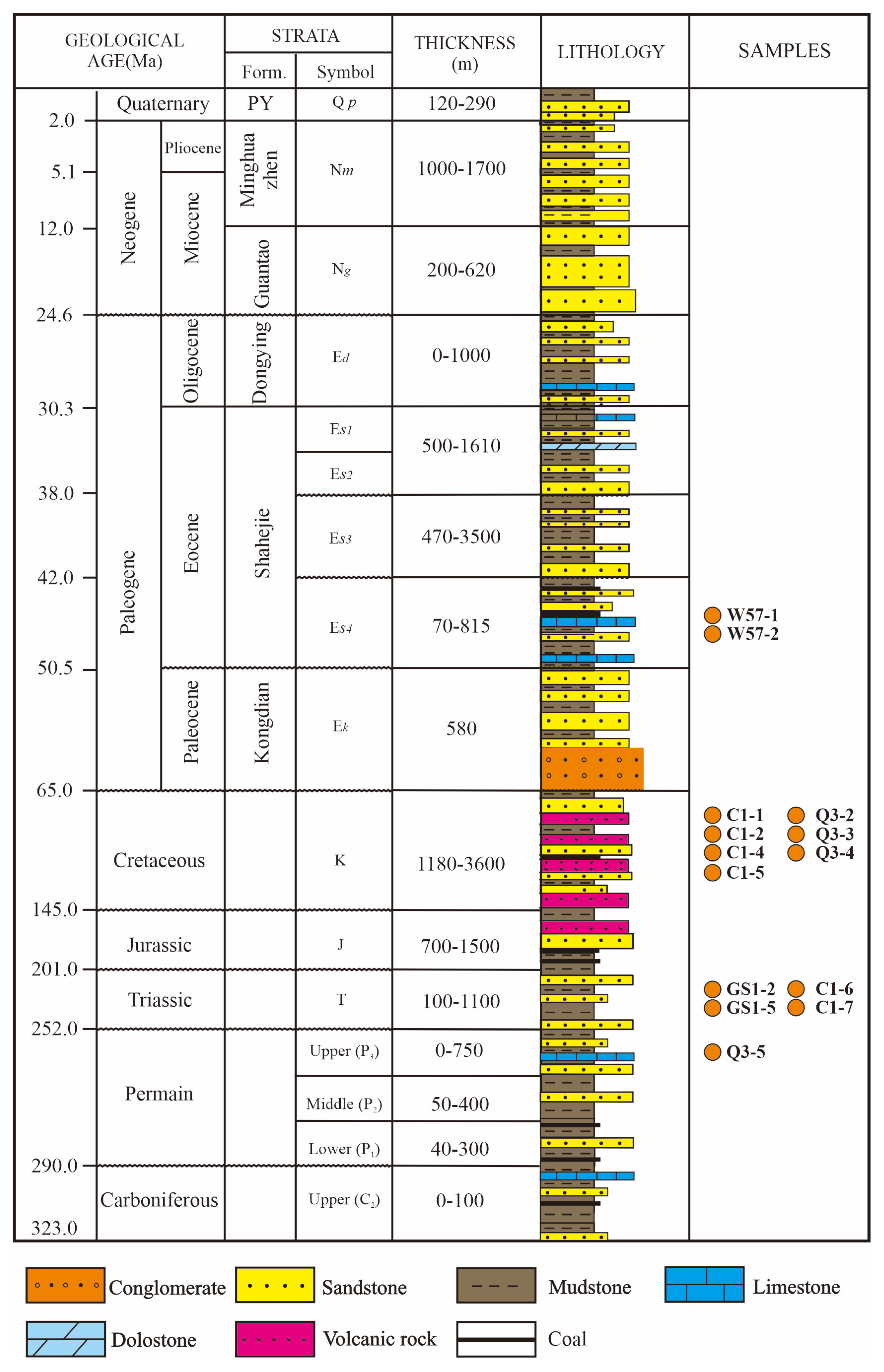
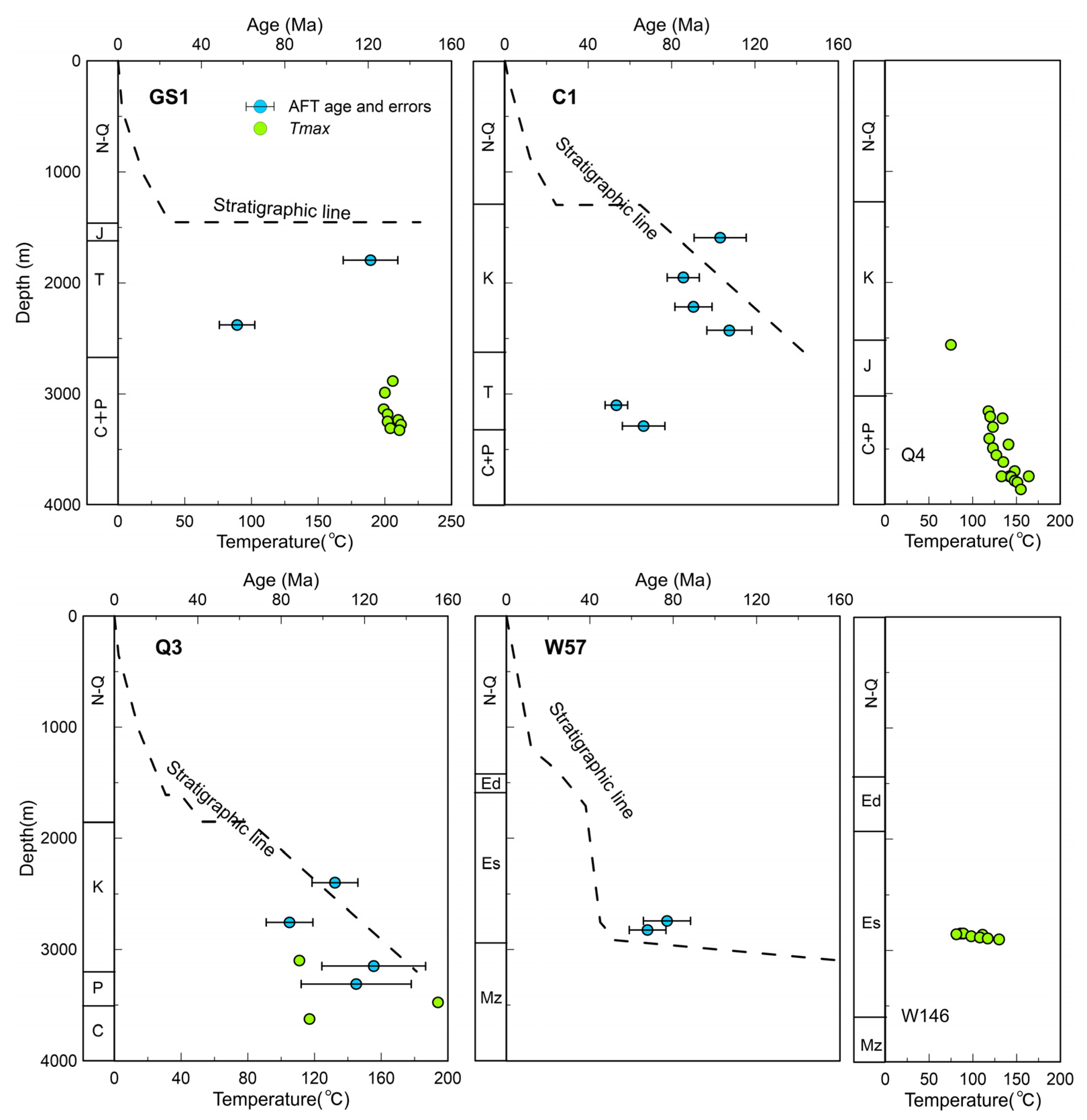

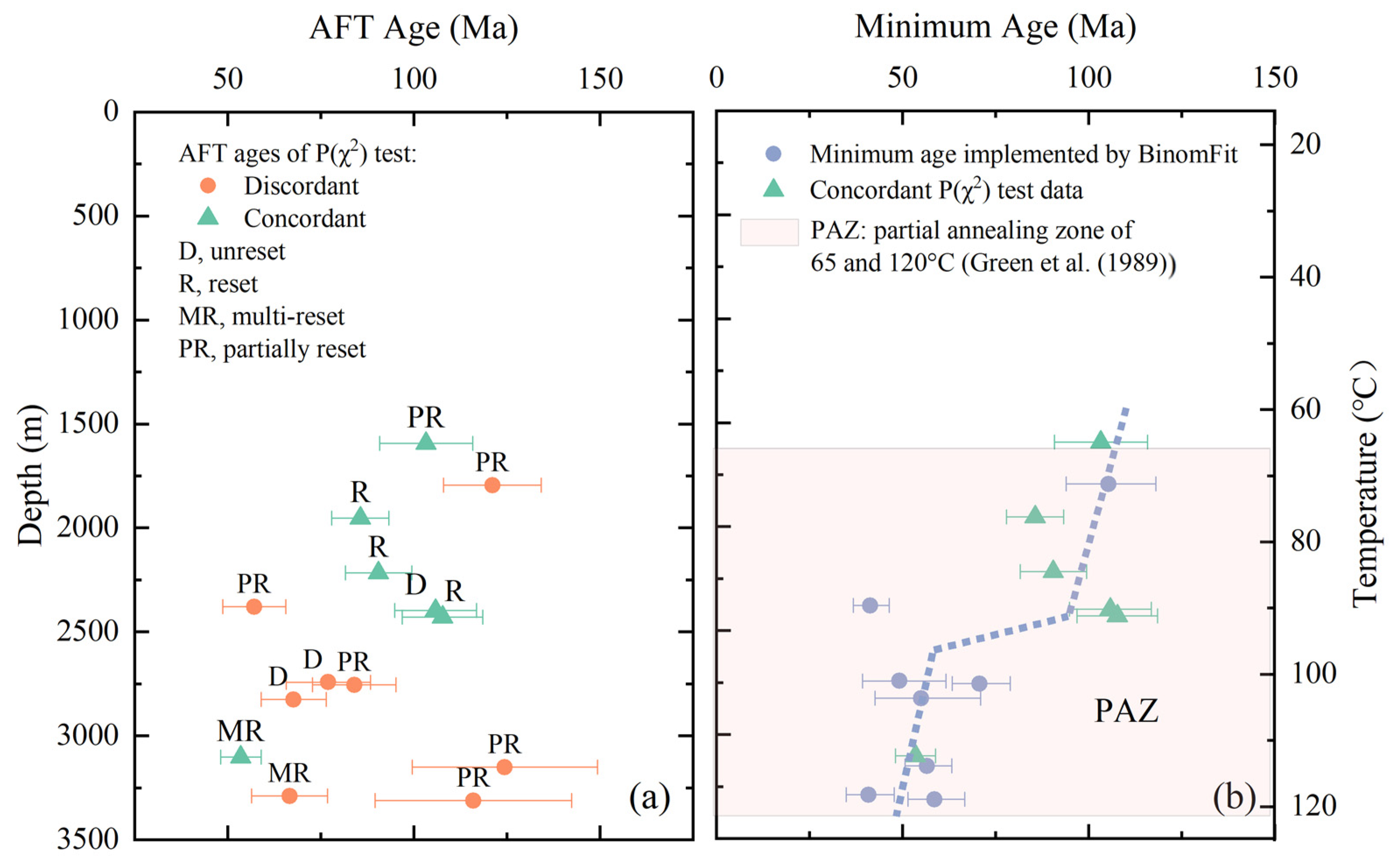
| Sample No. | Depth (m) | Form. | N | ρs (105/cm2) (Ns) | ρi (105/cm2) (Ni) | ρd (105/cm2) (Nd) | P(χ2) (%) | Age (Ma) (±1σ) | L(μm) (n) |
|---|---|---|---|---|---|---|---|---|---|
| GS1-2 | 1795 | T | 23 | 26.875 (638) | 21.273 (505) | 12.42 (7397) | 1.41 | 121.1 ± 13.1 | 11.0 ± 1.16 (131) |
| GS1-5 | 2379.5 | T | 20 | 26.33 (359) | 47.453 (647) | 12.65 (7397) | 0 | 57.1 ± 8.5 | 10.46 ± 1.58 (10) |
| C1-1 * | 1593.5 | K | 18 | 32.995 (236) | 28.661 (205) | 12.14 (7397) | 11.7 | 103.3 ± 12.5 | 11.07 ± 1.39 (104) |
| C1-2 * | 1952 | K | 23 | 21.604 (735) | 24.249 (825) | 12.98 (7397) | 64.4 | 85.6 ± 7.7 | 11.24 ± 1.27 (132) |
| C1-4 * | 2215.5 | K | 23 | 29.604 (501) | 29.722 (503) | 12.28 (7397) | 44.03 | 90.5 ± 8.9 | 11.18 ± 1.13 (119) |
| C1-5 * | 2428 | K | 23 | 32.58 (473) | 28.172 (409) | 12.61 (7397) | 21.15 | 107.7 ± 10.8 | 10.24 ± 1.13 (90) |
| C1-6 * | 3101 | T | 19 | 25.089 (360) | 42.094 (604) | 12.09 (7397) | 13.07 | 53.5 ± 5.4 | 9.90 ± 1.20 (53) |
| C1-7 * | 3288.6 | T | 22 | 23.879 (316) | 40.277 (533) | 12.33 (7397) | 0.01 | 60.1 ± 8.2 | 10.01 ± 1.20 (35) |
| Q3-2 | 2396.5 | K | 28 | 21.837 (413) | 18.664 (353) | 12.23 (7397) | 27.04 | 105.8 ± 11.0 | 10.34 ± 1.16 (58) |
| Q3-3 | 2755 | K | 20 | 24.218 (344) | 27.667 (393) | 12.37 (7397) | 0.14 | 84.0 ± 11.2 | 10.15 ± 1.18 (15) |
| Q3-4 | 3150 | K | 22 | 20.848 (634) | 19.894 (605) | 12.56 (7397) | 0 | 115.6 ± 22.3 | 10.68 ± 2.22 (13) |
| Q3-5 | 3311 | J | 17 | 22.559 (333) | 19.443 (287) | 12.70 (7397) | 0 | 116.0 ± 26.4 | 8.00 ± 2.51 (6) |
| W57-1 | 2824.8 | Es4 | 20 | 29.109 (247) | 41.365 (351) | 12.74 (7397) | 2.26 | 67.7 ± 8.8 | 8.69 ± 1.70 (34) |
| W57-2 | 2742 | Es4 | 19 | 27.896 (201) | 35.529 (256) | 12.47 (7397) | 2.46 | 77.0 ± 11.3 | 9.14 ± 1.47 (33) |
| Sample | Depth | Depo Age (Ma) | Type | Peak 1 (Ma) | 1S (±) | Frac.% | Peak 2 (Ma) | 1S (±) | Frac.% | Peak 3 (Ma) | 1S (±) | Frac.% |
|---|---|---|---|---|---|---|---|---|---|---|---|---|
| Gs1-2 | 1795.0 | 211 | PR | - | - | - | 105.3 | 11.4/12.8 | 77.0 | 215.7 | 65.3/92.9 | 23.0 |
| Gs1-5 | 2379.5 | 238 | PR | 41.3 | 4.5/5.1 | 70.8 | 93.1 | 21.2/27.3 | 20.1 | 261.0 | 84.7/124.2 | 9.2 |
| C1-1 | 1593.5 | 80 | PR | 58.6 | 16.4/22.7 | 19.9 | 124.6 | 18.2/21.3 | 80.1 | - | - | - |
| C1-2 | 1952.0 | 102 | R | - | - | - | 85.6 | 7.3/8.0 | 100 | - | - | - |
| C1-4 | 2215.5 | 120 | R | - | - | - | 90.5 | 8.3/9.2 | 100 | - | - | - |
| C1-5 | 2428.0 | 131 | R | - | - | - | 101.9 | 9.8/10.8 | 100 | - | - | - |
| C1-6 | 3101.0 | 220 | MR | 47.8 | 5.6/6.3 | 76.4 | 83.4 | 16.9/21.1 | 23.6 | - | - | - |
| C1-7 | 3288.6 | 227 | MR | 40.8 | 5.9/6.9 | 54.9 | 93.4 | 20.3/25.9 | 45.1 | - | - | - |
| Q3-2 | 2396.5 | 97 | D | - | - | - | 102.2 | 10.1/11.2 | 100 | - | - | - |
| Q3-3 | 2755.0 | 118 | PR | 70.7 | 7.4/8.2 | 85.5 | - | - | - | 277.6 | 77.8/107.3 | 14.5 |
| Q3-4 | 3150.0 | 143 | PR | 56.6 | 5.9/6.6 | 53.3 | - | - | - | 286.8 | 40.9/47.5 | 46.7 |
| Q3-5 | 3311.0 | 169 | PR | 58.6 | 7.1/8.1 | 63.7 | - | - | - | 394.8 | 71.8/87.2 | 36.3 |
| W57-1 | 2824.8 | 50 | D | 55.0 | 12.4/16 | 67.2 | 102.7 | 40.3/66.0 | 32.8 | - | - | - |
| W57-2 | 2742.0 | 48 | D | 49.2 | 10/12.5 | 40.3 | 106.4 | 19.3/23.5 | 59.7 | - | - | - |
Publisher’s Note: MDPI stays neutral with regard to jurisdictional claims in published maps and institutional affiliations. |
© 2021 by the authors. Licensee MDPI, Basel, Switzerland. This article is an open access article distributed under the terms and conditions of the Creative Commons Attribution (CC BY) license (https://creativecommons.org/licenses/by/4.0/).
Share and Cite
Xu, W.; Qiu, N.; Chang, J. Meso-Cenozoic Exhumation of the Linqing Sub-Basin, Bohai Bay Basin: Implications for Cratonic Destruction. Minerals 2021, 11, 1176. https://doi.org/10.3390/min11111176
Xu W, Qiu N, Chang J. Meso-Cenozoic Exhumation of the Linqing Sub-Basin, Bohai Bay Basin: Implications for Cratonic Destruction. Minerals. 2021; 11(11):1176. https://doi.org/10.3390/min11111176
Chicago/Turabian StyleXu, Wei, Nansheng Qiu, and Jian Chang. 2021. "Meso-Cenozoic Exhumation of the Linqing Sub-Basin, Bohai Bay Basin: Implications for Cratonic Destruction" Minerals 11, no. 11: 1176. https://doi.org/10.3390/min11111176
APA StyleXu, W., Qiu, N., & Chang, J. (2021). Meso-Cenozoic Exhumation of the Linqing Sub-Basin, Bohai Bay Basin: Implications for Cratonic Destruction. Minerals, 11(11), 1176. https://doi.org/10.3390/min11111176







